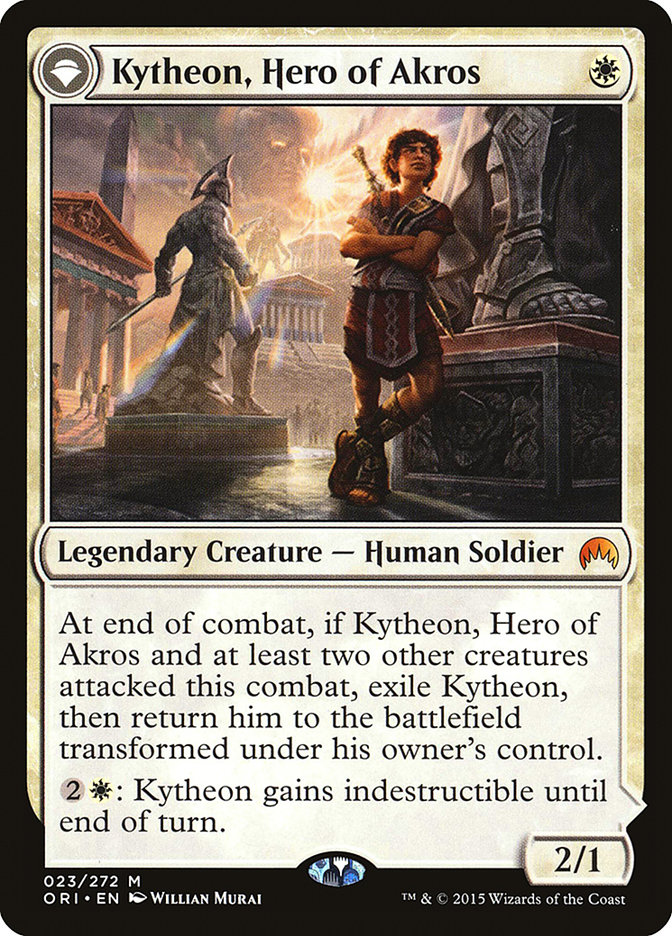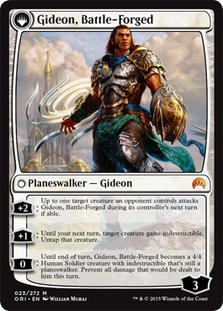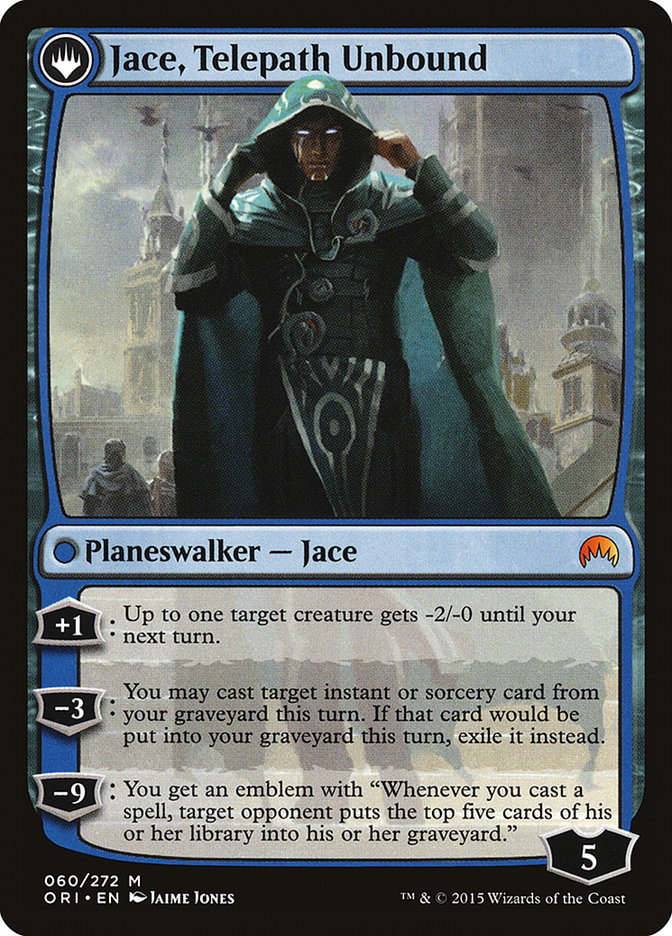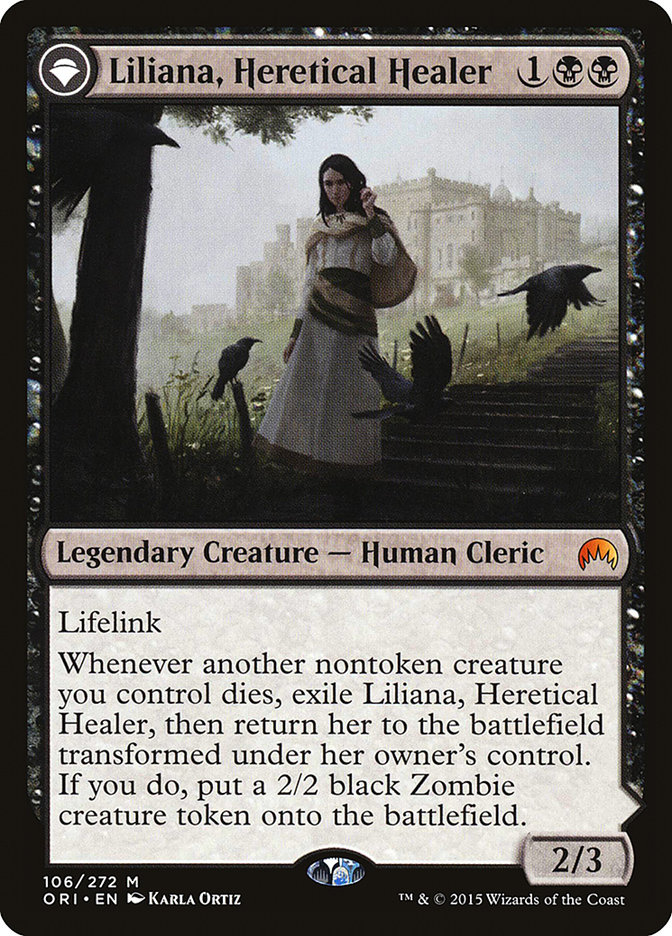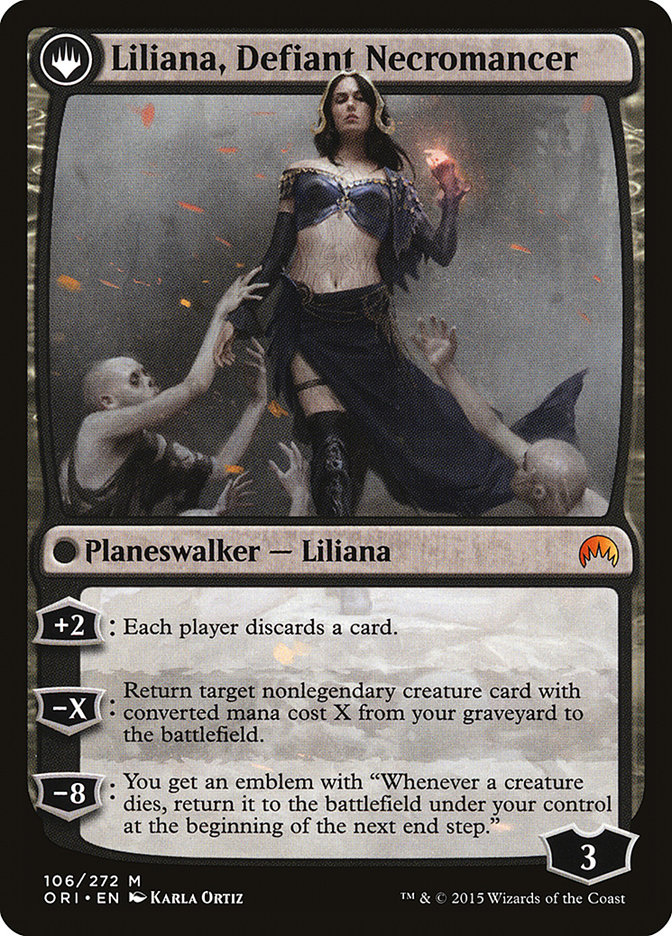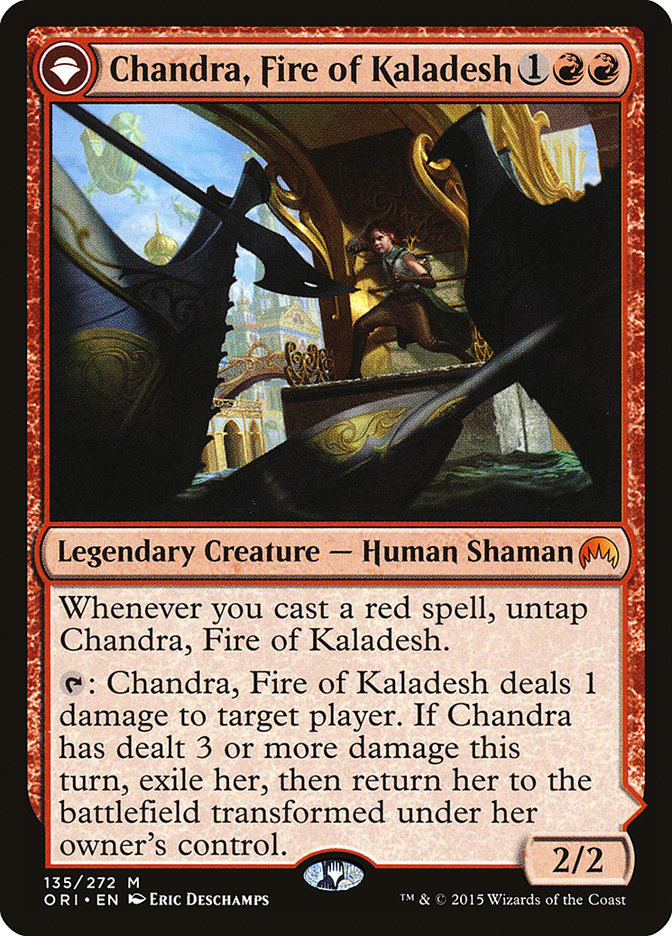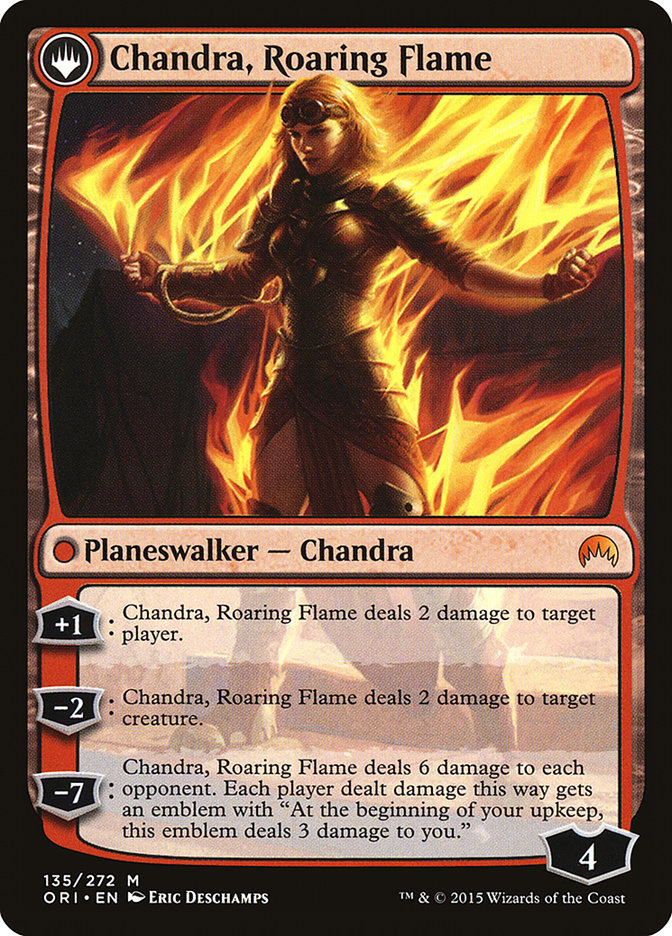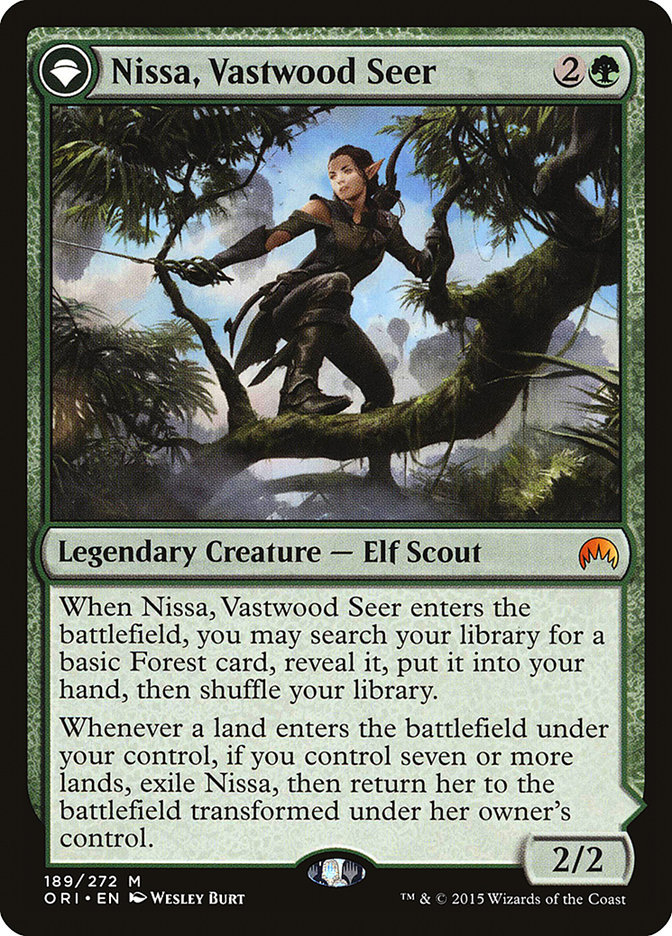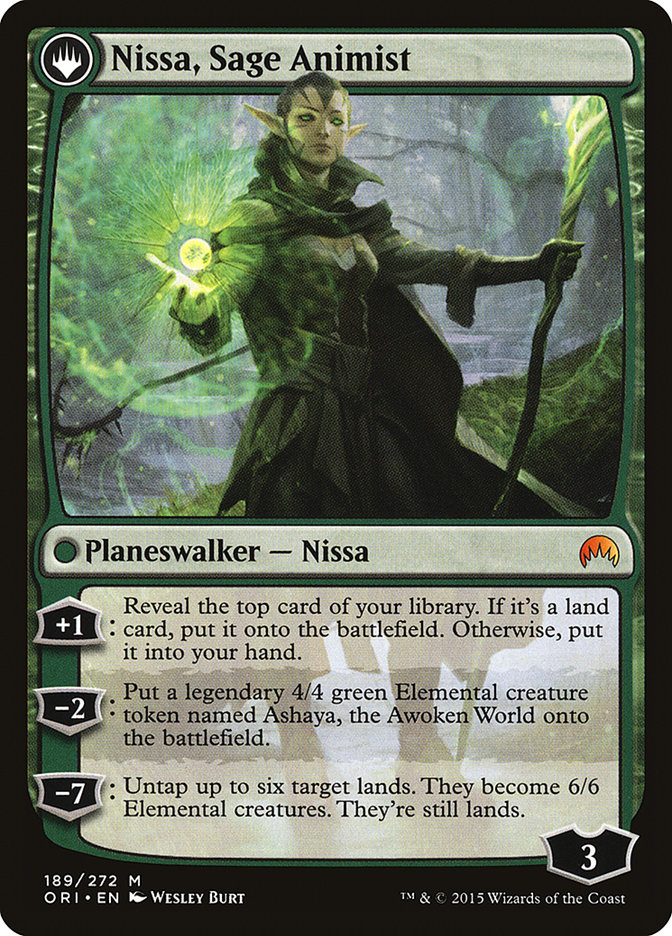Magic Origins has a unique take on planeswalkers that we haven’t seen anywhere else. We’re always looking to compare cards to others like them, and with a group of five cards that are only really like each other I thought it’d be best to look at all of them together.
It wasn’t long ago we were debating whether even including planeswalkers in Magic at all was a good idea. I think the answer is an unequivocal yes, but not necessarily for the reason you’d expect. To me, the strongest selling point is demonstrated by my enthusiasm about Magic Origins. Unlike a lot of competitive players, I care a lot about flavor in Magic (though really, I think the only unusual part comes in my acknowledging that). Flavor is absolutely essential to the game. It’s what allows us to parse and remember new cards, and it makes playing and thinking about the game a lot more fun. Sets with compelling flavor are a lot more interesting to me than other sets, which is why I’ve been a lot less enthusiastic about Theros and Khans of Tarkir compared to how I felt about Innistrad or Lorwyn.
By creating planeswalkers and building characters around them, showing their range and drawing our attention to them by printing several different versions of most of them, they’ve created characters we’re actually engaged with. Weatherlight and its related sets that filled out the “Weatherlight Saga” conceptually have a similar flavor to Magic Origins – a focus on some Magic characters, but Weatherlight is some of Magic’s least-compelling flavor to me and I was never given any reason to care about those characters. Planeswalkers let us start by getting engaged with the characters, and then Magic Origins lets us know more. Planeswalkers give their audience an opportunity to actually engage with their signature characters, which is great for the brand.
But, of course, you’re interested in playing with them… so let’s get to the cards themselves.
The first thing that jumps out at me is that these are all surprisingly easy to flip. They can all flip pretty easily the turn after they’re played, and Liliana and Nissa can easily be set up to flip immediately. The second thing that jumps out at me is that these are all great with Collected Company (Jace less so than the others). They allow you to fill your deck with hits for Collected Company while their ability to stop being creatures mitigates your exposure to sweepers, and it’s a lot more likely that you’ll get to flip any of them when you put them onto the battlefield at the end of your opponent’s turn off of Collected Company.
I could see several of these having a substantial impact in Modern. I expect Kytheon, Hero of Akros to become a Modern staple, though not necessarily in one of the best decks, and I expect it to be great in Standard.
Jace, Vryn’s Prodigy looks weak to me, but it might be good enough. Merfolk Looter has actually seen Constructed play, but only when it had either Merfolk synergies or Madness to interact with. A Merfolk Looter that can become a planeswalker sounds pretty good, but the planeswalker side looks incredibly weak. When I first read it, I was thinking the second ability let you cast the spell without paying its cost, and I was thinking about Jace, Thought Scour, and Cruel Ultimatum in Modern – but as-is, I’m not even sure that I’m happy when Jace transforms. I’ve cashed my Looter in for a Regrowth of sorts, but a very weak one, and I might get another in two turns or I could ignore those and just go for the ultimate, but it gets there very slowly and doesn’t accomplish anything along the way. This seems like it could be the worst of the batch. On the other hand, it’s possible that a Looter is actually good enough, as it can help enable Spell Mastery or Delve or generate other card advantage with the large number of cards in Standard that do something from the graveyard.
Liliana, Heretical Healer is a card I’m much more interested in trying out in Modern. I’m imagining playing Viscera Seer, then Voice of Resurgence, then cast Liliana, sacrifice Voice of Resurgence, make both an elemental and a zombie as Liliana flips, then return my Voice of Resurgence – now I’ve played an Elemental Token, and Zombie Token, and a one-loyalty planeswalker for three mana and a single card. That’s pretty solid. As far as three-card perfect curves in Modern go, it’s nothing special, but there are a lot of variations that lead to something comparable and in some spots, I can just play Liliana as a creature alongside a sac outlet and another creature and either hold the ability to flip her at instant speed or just flip her immediately and start attacking hands. It also gives me a reason to try to build more Bloodghast decks, which is always a plus in my book.
Chandra, Fire of Kaladesh is nowhere near Kytheon’s power level, but she does flip pretty easily if you untap with her – if they don’t have a blocker you only need one red spell, if they do have a blocker you need two, but alongside whatever benefit you get for casting those two red spells they take five damage that turn and you have a reasonable Planeswalker threat in play. It’s a two-toughness three-drop that doesn’t do anything the turn you play it, so it’s not easy to justify putting Chandra in your deck over Goblin Rabblemaster, but she might have a chance after rotation or as an alternative if you’re really looking to minimize your exposure to sweepers by playing a creature that can become a planeswalker.
Nissa, Vastwood Seer is great. She won’t flip early, but she will be a Civic Wayfinder that doesn’t fix your colors but which your opponent will actually have to kill eventually. Where I really see Nissa shining is on turn seven when you play her, grab your seventh land, play that, flip Nissa and activate her immediately. That’s a real part of the game that comes up a lot in Standard, and the fact that you get a card that’s powerful enough to matter at that point in the game while still having a fine card to cast early on makes Nissa a great card. She also works particularly well with some of the other best green cards – she gets you a land to help get to the point where you can play and flip Den Protector while supplementing the general grinding strategy that those decks are looking for. Later in the game, she becomes a powerful threat to return with Den Protector.
With Collected Company, Nissa lets you keep a low land count so that you can have more creatures in your deck while being able to hit a fourth land, and Nissa is a great card to have the option to choose or not choose off of Collected Company – if you need another land or if it’s late in the game and you have a lot, take this; if you don’t, you may be able to just skip her and take two other creatures.
One card that I think Nissa slightly more subtly encourages is Dragonlord Atarka, just because she helps make sure you actually get to seven mana and building up to Dragonlord Atarka specifically mitigates the weakness of only getting Forests because Atarka’s color requirements aren’t the least bit challenging.
My power level ranking for the new Planeswalkers is:
Kytheon
Nissa
Liliana
Jace
Chandra
I think Kytheon and Nissa are great, Liliana is interesting, and the others are fringe curiosities.
Kytheon, Hero of Akros will likely have the biggest impact on Standard of any card in Magic Origins. Mono-White Aggro hasn’t been playable, but a dedicated Soldiers/Obelisk of Urd deck has always been just a little short, and Kytheon is incredibly perfect for that deck, giving it an outstanding one-drop that helps avoid a lot of the decks biggest weaknesses, sweepers. The incentive to stay Mono-White with Kytheon comes from avoiding having any tapped lands which might prevent flipping him as early as possible. Raise the Alarm by itself makes Kytheon a constant threat to flip even if he’s alone in play.
Ross Merriam wrote about Soldiers with Kytheon as a two-color Heroic deck useing Akroan Crusader, but I’d be pretty worried about my Hammerhand/Titan’s Strength/Obelisk of Urd draws that don’t have Akroan Crusader. I do love Hammerhand with Kytheon, and Akroan Crusader, Zurgo, Monastery Swiftspear, Goblin Rabblemaster, and other haste creatures with Kytheon, but I don’t think combining Heroic with Obelisk of Urd is the way to go.
I’d try to keep Mono-White and keep my soldier count as high as possible:
Creatures (25)
- 4 Soldier of the Pantheon
- 4 Nyxborn Shieldmate
- 4 Hero of Iroas
- 4 Brimaz, King of Oreskos
- 1 Herald of Anafenza
- 4 Anafenza, Kin-Tree Spirit
- 4 Kytheon, Hero of Akros
Lands (22)
- 22 Plains
Spells (9)
Sideboard

This isn’t a strategy that’s been good enough before in this Standard season, but Kytheon could push it over the top. Still, it might be better to play fewer bad cards, even if that means playing some tapped lands.
Red is the most obvious color to pair Kytheon with because of its access to haste creatures, and, at least as importantly, cheap removal to help Kytheon actually live through attacking.
Consider:
Creatures (21)
- 4 Goblin Rabblemaster
- 4 Monastery Swiftspear
- 2 Goblin Heelcutter
- 3 Soulfire Grand Master
- 1 Lightning Berserker
- 3 Zurgo Bellstriker
- 4 Kytheon, Hero of Akros
Lands (23)
Spells (16)

This deck makes much better use of Kytheon – it’s very good at flipping into Gideon without needing to untap with three creatures thanks to its fourteen functional haste creatures (plus three more in the sideboard) and a huge amount of cheap removal to clear blockers. I don’t usually like Flamewake Phoenix, but I wanted more threats to bring in when my removal spells are bad, and I like getting another haste creature in there. I can only bring it back with the Ashcloud Phoenixes I’m also bringing in, but that’s better than nothing.
I expect Kytheon to play well in G/W Aggro with or without Collected Company or in Abzan Aggro with Collected Company, but I’m not really sure what the list would look like as I don’t really know the best way to build those decks in general right now.
Jace, Vryn’s Prodigy’s best chance is likely in something like this:
Creatures (27)
- 4 Sylvan Caryatid
- 4 Courser of Kruphix
- 4 Satyr Wayfinder
- 1 Pharika, God of Affliction
- 3 Sidisi, Brood Tyrant
- 2 Tasigur, the Golden Fang
- 4 Den Protector
- 3 Jace, Vryn's Prodigy
- 2 Nissa, Vastwood Seer
Planeswalkers (1)
Lands (23)
Spells (8)

Even here I’m skeptical that Jace is really worth it, but this kind of deck definitely likes selection and filling its graveyard, and Jace plays well with both Nissa and Satyr Wayfinder as you’ll often want to be able to turn those lands into spells. Jace is also nice with a lot of delve letting you decide whether to flip him or not.
Liliana, Heretical Healer really wants to play with sac outlets, currently really lacking in Standard, so I’d be surprised if Liliana shows up there until some good outlets are printed. In Modern, she could obviously just be slated into an Abzan Collected Company deck, but I suspect she isn’t doing enough there since she doesn’t participate in the combo.
Perhaps a better approach is to try to maximize her +2 ability – the text is the same as Liliana of the Veil but gaining loyalty twice as fast is a substantial upgrade, so if your primary goal is to use the discard mode, the Defiant Necromancer can be a better fit. We’d want to be able to sacrifice creatures, empty our hand quickly, and maybe take advantage of discarding cards – possibly something like this:
Creatures (25)
- 4 Greater Gargadon
- 4 Bloodghast
- 4 Viscera Seer
- 4 Gravecrawler
- 4 Gurmag Angler
- 1 Risen Executioner
- 4 Liliana, Heretical Healer
Lands (22)
Spells (13)
Sideboard

Gurmag Angler is a huge upgrade to this kind of deck. It offers a large blocker that can come down early enough to usefully return Gravecrawler and a different path to winning than just attacking with small creatures. Faithless Looting, fetchlands, and Liliana make Delve relatively easy. Greater Gargadon is intended to function here not just as a combo-enabling sacrifice outlet but an active threat and finisher. Between Bloodghast and Gravecrawler it can come down and end a game surprisingly quickly, and it plays really well with Liliana, Defiant Necromancer in that while it’s suspended, the opponent can’t use their removal spells on it while Liliana forces them to empty their hand, leaving them without an answer when the huge creature enters the battlefield.
Nissa, like Kytheon, is powerful enough to fit into a wide range of strategies, but she might be particularly well-suited to building up Jund as a new archetype:
Creatures (23)
- 4 Elvish Mystic
- 4 Sylvan Caryatid
- 4 Courser of Kruphix
- 1 Hornet Nest
- 1 Ashcloud Phoenix
- 1 Whisperwood Elemental
- 1 Tasigur, the Golden Fang
- 2 Dragonlord Atarka
- 1 Dragonlord Kolaghan
- 3 Nissa, Vastwood Seer
- 1 Woodland Bellower
Planeswalkers (5)
Lands (24)
Spells (8)

This deck is obviously a descendant of Bees, but it moves away from Hornet Nest as a primary plan to make room for Nissa as a better three-drop and uses that to focus more on the big spells in the deck. Black is primarily included because I think Garruk, Apex Predator is a really good fit for this deck, but having a three-drop that creates card advantage rather than a three-drop that’s sometimes part of a combo finish and sometimes essentially blank makes spot removal better. I’m trying to be able to transition into a value deck against control with Nissa, Thoughtseize, Den Protector, Kolaghan’s Command, and planeswalkers, then relying on having access to the strength of Chord of Calling with Hornet Nest against creature decks. It’s possible that the sideboard needs more copies of Hornet Nest because of just how good they are in some matchups; by retaining much of the old Bees shell, the deck is well-positioned to take advantage of them.
I haven’t built a deck with Chandra, as I just don’t think her time has come yet, if it ever will. Still, I’m excited to play with these cards that will function very differently from other creatures or planeswalkers, and I’m excited to see more of their stories as the rest of the set unfolds.

